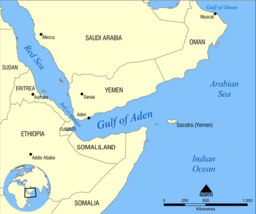
Back Golf van Aden Afrikaans خليج عدن Arabic ܒܪܩܩܐ ܕܥܕܢ ARC Golfu d'Adén AST Ədən körfəzi Azerbaijani عدن کؤرفزی AZB Адэнскі заліў Byelorussian Адэнская затока BE-X-OLD Аденски залив Bulgarian এডেন উপসাগর Bengali/Bangla
| Gulf of Aden | |
|---|---|
 | |
 The Gulf of Aden, as viewed from space (top) and on a map (bottom) | |
| Location | East Africa and West Asia |
| Coordinates | 12°N 48°E / 12°N 48°E |
| Type | Gulf |
| Basin countries | |
| Surface area | 410,000 km2 (160,000 sq mi)[dubious ] |
| Average depth | 500 m (1,600 ft) |
| Max. depth | 2,700 m (8,900 ft) |
| Max. temperature | 28 °C (82 °F) |
| Min. temperature | 15 °C (59 °F) |
| Settlements | Aden, Mukalla, Balhaf, Berbera, Bulhar, Maydh, Djibouti, Zeila, Las Khorey, Bosaso |
The Gulf of Aden (Arabic: خليج عدن; Somali: Gacanka Cadmeed) is a deepwater gulf of the Indian Ocean between Yemen to the north, the Arabian Sea to the east, Djibouti to the west, and the Guardafui Channel, Socotra and Somalia to the south.[2] In the northwest, it connects with the Red Sea through the Bab-el-Mandeb strait, and it connects with the Arabian Sea to the east. To the west, it narrows into the Gulf of Tadjoura in Djibouti. The Aden Ridge lies along the middle of the Gulf and is causing it to widen about 15mm per year.
The ancient Greeks regarded the gulf as one of the most important parts of the Erythraean Sea. It later came to be dominated by Muslims, as the area around the gulf converted to Islam. From the late 1960s onwards, there started to be an increased Soviet naval presence in the Gulf. The importance of the Gulf of Aden declined when the Suez Canal was closed, but it was revitalized when the canal was reopened in 1975, after being deepened and widened by the Egyptian government.
The waterway is part of the important Suez Canal shipping route between the Mediterranean Sea and the Arabian Sea in the Indian Ocean, with 21,000 ships crossing the gulf annually.[3] This route is often used for the delivery of Persian Gulf oil, making the gulf an integral waterway in the world economy.[4][5] Important cities along the Gulf of Aden include the namesake Aden in Yemen. Other Yemeni cities are Zinjibar, Shuqrah, Ahwar, Balhaf, Mukalla. On the Horn African side, the cities of Djibouti, Berbera and Bosaso.
Despite a lack of large-scale commercial fishing facilities, the coastline supports many isolated fishing towns and villages. The Gulf of Aden is richly supplied with fish, turtles, and lobsters.[6] Local fishing takes place close to the shore; sardines, tuna, kingfish, and mackerel make up the bulk of the annual catches. Crayfish and sharks are also fished locally.
- ^ Michael Hodd, East Africa Handbook, 7th Edition, (Passport Books: 2002), p. 21: "To the north are the countries of the Horn of Africa comprising Somalia, Ethiopia, Eritrea,and Djibouti, "
- ^ Lytle, Ephraim. "Early Greek and Latin Sources on the Indian Ocean and Eastern Africa." Early Exchange between Africa and the Wider Indian Ocean World. Palgrave Macmillan, Cham, 2016. 113-134.
- ^ "Pirates fire on US cruise ship in hijack attempt: Yahoo! News". Yahoo!. Archived from the original on December 4, 2008. Retrieved 2008-12-04.
- ^ Cite error: The named reference
:0was invoked but never defined (see the help page). - ^ Cite error: The named reference
:1was invoked but never defined (see the help page). - ^ "Aden, Gulf of | Encyclopedia.com". www.encyclopedia.com. Retrieved 2019-06-14.
© MMXXIII Rich X Search. We shall prevail. All rights reserved. Rich X Search